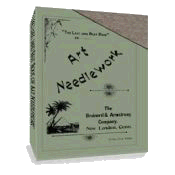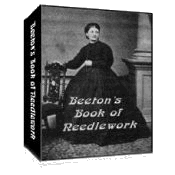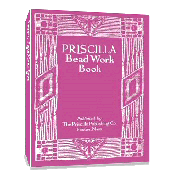[]Subscribe To This Site
Wallachian Embroidery
c. 1908
The simplicity and effectiveness of Wallachian Embroidery, together with its inexpensiveness and the ease with which it may be learned and accomplished even by amateur needle-workers, are the greatest factors in its popularity.

Click on picture to see more detail.
Wallachian embroidery, which takes its name from the place its origin, Wallachia, was originally done flat on rather coarse material with heavy thread of various colors, the designs being stiffly conventional. The present adaptations of this work show it in any material that can be embroidered, from heavy burlap of which pillow tops and table covers are made to the sheer fabrics for infants' wear, and, of course, the thread employed must correspond with the material on which the embroidery is done. Often the work is padded and raised and many new and graceful motifs introduced.
The keynote of Wallachian embroidery, its principal characterizing feature, is the simple button-hole-stitch. This and one or two other simple stitches are all that is necessary for one to know to be able to do the embroidery, and by studying the details of stitches on this page the principles of the work are easily understood.
In making the circles, first punch a hole in the center and work the buttonhole stitch from the center out as illustrated. The hole may be large enough to show when the figure is complete, or it may fill up, but in either case it prevents the over-lapping of the stitches. The leaves are done with a slanting stitch from the vein outward, always keeping the purl on the edge. In the oval leaves where the ends round, it is safer to punch a small hole at the end of the vein so that the threads will not overlap.
It is not always necessary to have both sides of a figure buttonholed, as is illustrated in the crescent, which is introduced effectively in many designs.
Stems are sometimes in outline as shown here, sometimes in satin stitch (the familiar over and over stitch), or in chain stitch, and if a narrow band too wide for outlining comes into the design it may be effectively carried out in the dovetail button holing, which is shown in the lower right corner of the cut. The stitches of this detail are purposely made far apart so as to show the principle clearly, but in the real work they should lie close together and fill the space completely. To do it, buttonhole down one side, taking stitches nearly across the space and go back on the opposite side, taking stitches the same length and letting them interlace with the first.
Wallachian embroidery was particularly suitable for such dress accessories. See Victorian Dress Accessories for more information.
Return to top of Wallachian Embroidery page.
Return to Types of Embroidery page.
Return to Home page.



 433 pages!
433 pages!

